The Dell Venue 11 Pro 7000 Review
by Brett Howse on April 16, 2015 8:00 AM EST- Posted in
- Tablets
- Dell
- Windows 8.1
- Core M

Back in November, Dell took the lid off of their Venue 11 Pro 7000 refresh which is their first tablet offering to have Core M powering it. Dell is aiming this tablet squarely at the enterprise segment, but with prices that start low enough for consumers to take a look as well. Starting at $699, it is not an inexpensive device, but it does offer some compelling features on top of the powerful (for a tablet) processor. Dell has an entire range of accessories for the tablet to let the end user get the maximum out of the device, and allows the device to be used as a tablet, a laptop, or even a desktop computer.
Dell has leveraged the Intel Core M processor to power this tablet, which gives it quite a bit of a performance boost over most tablets. There are two offerings as well, with the Core M-5Y10c being the base model, and the Core M-5Y71 being the upgrade. Those who opt for the 5Y71 will enjoy the benefits of Intel vPro as well as the peak performance boost of the faster clock speeds of that model.
| Dell Venue Pro 11 7140 Specifications | |
| Processor | Intel Core M-5Y10c (Dual-core + HT 0.8-2.0GHz 4MB L3 14nm 4.5W TDP) Intel Core M-5Y71 (Model Tested) (Dual-core + HT 1.2-2.9GHz 4MB L3 14nm 4.5W TDP) |
| Memory | 4 or 8 GB (model tested) LPDDR3-1600 |
| Graphics | Intel HD 5300 (24 EUs at 100-800MHz on 5Y10c) (24 EUs at 300-900MHz on 5Y71) |
| Display | 10.8" IPS 16:9 FHD (1920x1080) (Samsung SDC4C48 8-bit Panel) 10-point Multitouch |
| Storage | 64GB / 128GB (model tested) / 256GB SSD (Sandisk X110 M.2 2280) |
| Networking | Intel Dual Band Wireless-AC 7265 plus Bluetooth 4.0 (2x2:2 802.11ac 867Mbps capable) Optional LTE |
| Cameras | 2 MP Front Webcam 8 MP Rear Camera |
| Battery/Power | 38 Wh non-removable 24 W Max AC Adapter |
| Ports and I/O | Headset Jack MicroSD Card Reader 1 x USB 3.0 1 x micro HDMI NFC Optional Sensor Hub (Gyro, G-Sensor, Proximity) |
| Operating System | Windows 8.1 64-bit or Pro |
| Dimensions | 11.01" x 6.95" x 0.42" (WxDxH) (279.8mm x 176.4mm x 10.75mm) |
| Weight | 1.59 lbs (722.6g) Wi-Fi 1.65 lbs (747.7g) LTE |
| Pricing | $699 (5Y10, 4GB, 64GB) $749 (5Y10, 4GB, 128GB) $829 (5Y71, 4GB, 128GB) Contact Dell for other options |
The Venue 11 Pro 7000 (henceforth called Venue 11 Pro) is truly an Ultrabook in a tablet form factor, with 4 to 8 GB of memory on tap, 64 to 256 GB of solid state storage, and Windows 8.1 64-bit powering the system. Dell has an optional 4G LTE modem as well, which is something that still seems to be a rare feature on these types of systems.
Accessories
While the Venue 11 Pro is a reasonable tablet on its own merits, what really makes this device is the accessories. Dell has practically everything covered too. If you need a keyboard and extended battery life, they have that. If you want a thin keyboard only, they have that too. A stylus? Check. Docking station? Of course. How about just a case that can be used as a stand? Yes.
Dell Tablet Folio
The folio includes a polycarbonate rear shell which keeps access available to the tablets ports. The front cover will fold behind and double as a stand. Dell sells this case for $24.99.
Dell Venue Keyboard - Slim
This slim keyboard is very much like the Microsoft Surface keyboard covers. Very thin, and yet they feature a keyboard and trackpad. Dell did not send this accessory with the review unit, so I can’t comment on the key feel, but they do claim it has a tactile response. It also features an integrated tablet stand, which of course would be required since this tablet has no way of holding itself up. At just 3.6 mm thick, it is very much similar to the Surface Touch cover in thickness, and it will add 313 grams to the total tablet weight.
The magnetically attached cover is going to come with the same drawbacks of the Microsoft Surface line of attachable keyboards. Although it is thin and light, it really works best on a desk rather than in a lap. While it can be used in a lap in a pinch, it is not ideal. The Slim keyboard is priced at $89.99.
Dell Venue Keyboard – Mobile
For those that want to use the tablet as a convertible laptop, the Mobile keyboard is likely your best bet. The tablet locks into the hinge of this keyboard, and with that proper connection it can be used just like a laptop – albeit a small laptop. The 10.8 inch display means that the accessory is much smaller than a traditional laptop keyboard would be. While the keyboard itself is sized pretty well, it is really the trackpad that suffers, since it is very small.
Dell offers one great feature with this keyboard though. It includes an additional battery, which bumps the tablet’s battery capacity to around 60 Wh total. That is a huge amount of battery for a low powered device, and can really extend the usable lifespan of the tablet which we will see later in the review.
All is not perfect with this keyboard though. First, the price is a very high $179.99. The keyboard and battery costs almost as much as the HP Stream 11 laptop. If it was a premium accessory, perhaps the price could be justified, but there are some major gripes I have with the keyboard. The keys themselves are very mushy and not a great typing experience. Also, there is no backlighting offered, which limits the usability in many scenarios. The trackpad was also not very good. Besides the limited surface area for it, it would often miss taps and it was frustrating to use. The hinge also lifts the rear of the laptop up, and while Dell’s solution is much better than the ASUS Zenbook which does the same thing, ergonomically this benefits no one. Finally, the mobile keyboard adds a lot of thickness and mass to the overall tablet package, with the keyboard coming in at 8.9 mm thick, and a staggering 794 grams. It actually weighs even more than the tablet on its own, over doubling the effective weight.
The keyboard can be charged separate from the tablet, but the power connector has to be plugged into the tablet if both are connected together. It would have been nice for Dell to put the keyboard charging port on the side of the keyboard to allow the power connector to hook up there instead of the side of the tablet when it is being used as a laptop. I do not really have a lot of good things to say about this accessory other than it does do a good job of increasing battery life.
Dell Active Stylus
Dell’s Active Stylus is a Synaptics unit. There have been several revisions of the pen, and the previous Venue 11 Pro also supported an active stylus. Dell has a new model available now, and the new pen works very well. It is smooth to use on the display, and there was never any moments where connectivity would be lost. I am not a stylus expert like some people (ie Gabe at the Penny Arcade) but I had no issues using this model of stylus. The only slight issue was using the pen at the very edges of the display, where the pointer would sometimes jump right to the edge.
Dell Tablet Dock
Unlike the mobile keyboard, the tablet dock is very well constructed. The frame is made out of a piece of stamped steel which is painted black, so it is plenty sturdy. The mass of it also makes it feel well constructed, and the entire bottom is covered in rubber to keep it from moving around on the desk.
Once docked, the tablet basically transforms into a full desktop. There are two USB 3.0 ports on the rear of the dock, and another on the front. The dock includes 10/100 Ethernet, HDMI, DisplayPort, and has a front headphone jack. The dock also includes a 65 watt power adapter, which should easily power the system and any USB accessories. The best part of this dock is the relatively low price at just $79.99.


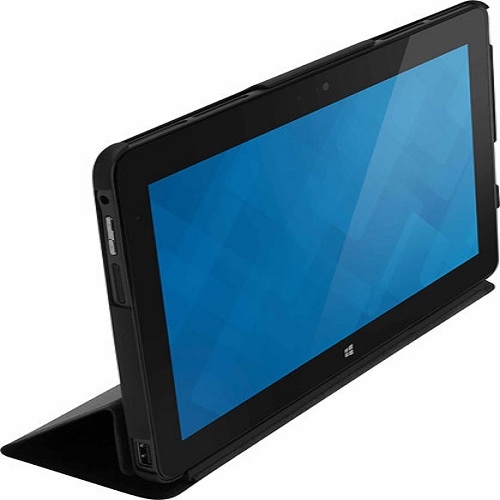
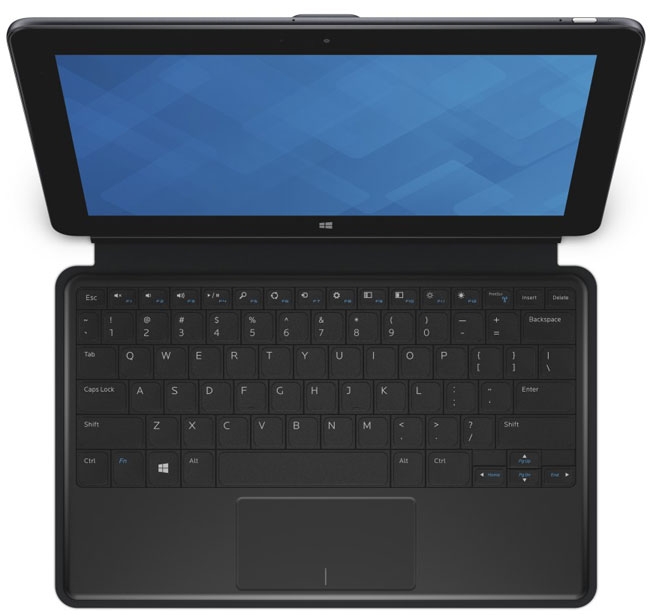
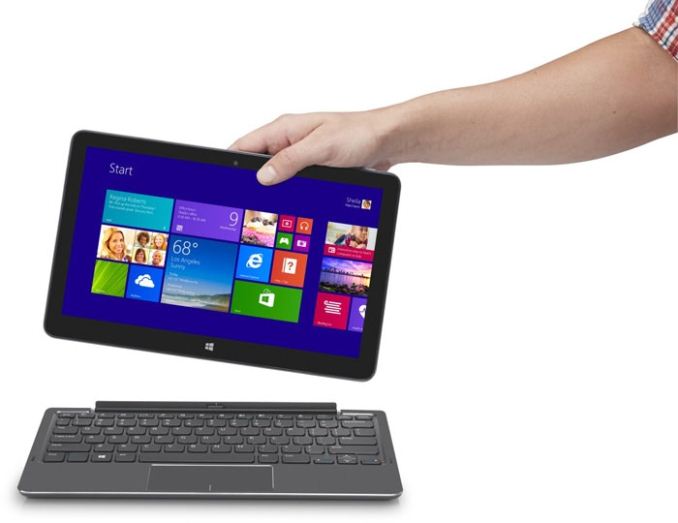
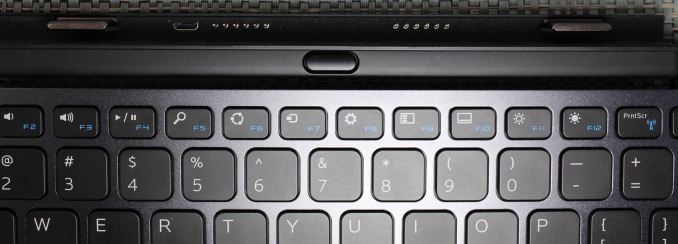

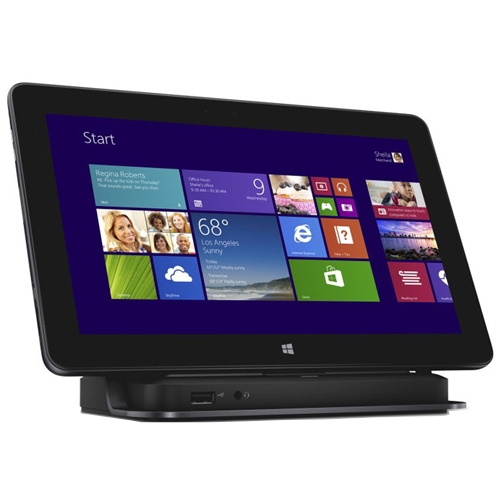








92 Comments
View All Comments
xthetenth - Thursday, April 16, 2015 - link
If by soon you mean years from now sure. Right now the speed comparison has a huge gulf between Core M and everything else in that power range. I really don't get how people manage to keep making predictions this bad. It's probably because they decide before reading about what they're talking about.jjj - Thursday, April 16, 2015 - link
The Denver core is odd but it's not that far behind is some situations even on 28nm.If they tune it further and goes 14nm things would get a lot better.AMD we have no clue where it lands, Qualcomm's new core got to be faster than A72 and A72 is pretty fast.
Apple even with just a shrink to 14mm wouldn't be that far behind.
So when i said soon i meant soon.
After all Core M has big cores clocked way low, shouldn't be that hard to beat it since the core is likely outside it's optimal range.Someone that would design the core for such a TDP would have a big advantage.
MrSpadge - Thursday, April 16, 2015 - link
If you're fine with the performance and software collection those cheap ARM SoC's can offer you - fine, but then compare to Silvermont rather than Core M. Having ultra mobily performance and x86 is worth a lot to some people. Let the market decide if it's enough to warrant such a product.nerd1 - Friday, April 17, 2015 - link
Still has IMMENSELY better value than apple's core M product.akdj - Saturday, April 18, 2015 - link
...? Apple's MacBook? With a phenomenal display, the fastest storage available, 256GB PCIe storage solutions and less than a Kg? Is there a hiDPI computer running Win 8(,1/10) you can point to that is achieving what Apple has with its MacBook (again, brand new, the R&D costs recovered and you've got quick price breaks with a phenomenal operating system that works seamlessly to aggregate and integrate with your mobile devices, and continuity with Handoff ...and you can run Windows!). The trackpad, the new keyboard. ARS isn't known to be an Apple fans paradise but it's a great review, phenomenal display, ultra light (he compares with a 11" MBA), fast as hell and incredible battery life. Nice to leave the Chargers and wires at home. It's a 'second' laptop solution to most and to those as a primary ownership computer, I'm sure they're not rendering Pro-Res from an HDV codec and transcoding video for 'speed'. They're checking Facebook, Twitter, email and surfing. Word processing and media enjoyment. For these tasks alone, it's prefect (& able to run 4k @ 30hZ. Not bad) as their solo computer. Makes me laugh as my wife was using the MacBook core 2 duo 2007 @ 2.16GHz/2GB/120GB spinner until two years ago. Bought the MBA for her in 2011 and it's still kicking ass and it's what SHE needs (she's a twenty two year pilot in Alaska me uses iPads and the MBA for flight planning and navigation, a test system (NextGen) with the FAA using three dimensional terrain, weather and traffic information, flight planning and diversion, real time weather and traffic, NFZs or other advisories.The LAST thing she wants at home is a four pound laptop or two pond tablet at home for enjoyment when she's not at work ...me, I run the business side and we concentrate on audio and visual production across the state of Alaska. Until a year ago I was dumping P2 cards off to a 15" PowerBook because of the perfect PCMICA slot, with FCP7, field edits and hacks were easily tackled. Now with less pricey proprietary transfer and encoding we've switched to rMBPs solely in the field and a pair of MacPros at the studio. I need the power to finalize but she's doing all the heavy lifting and safety with MUCH less power but significantly better battery life than the tools I use. I've every intention of buying one when they hit for her. It's a helluva laptop
khanikun - Wednesday, April 22, 2015 - link
Fastest storage available? You do know that most companies just put some random SSD into their tablets, laptops, etc. Usually some cheap value brand to save on costs. Hardly the fastest available storage. If it was, aftermarket SSD companies wouldn't be making bookoo dollars.As for comparison, really. Have you not even seen a Surface Pro 3? The thing spanks the Macbook in performance, all while being a year older. Now there are pros and cons for both, where a user's usage will dictate which is the better purchase for their needs.
The Surface Pro 3 is both thicker and thinner than the Macbook. It's also lighter and heavier than the Macbook. Depends on whether you add in the keyboard.
SP3 is MB share the same battery life, but expect the MB to loose if you bootcamp, cause you know the thing's battery life goes a bit down the drain when it tries to run Windows.
PPI screens are comparable, with the MB a little better. At the same time, the SP3 is a touchscreen and has an awesome stylus.
Performance, SP3 wins that easily, but it also costs more, if you configure it to have the same storage option as the MB.
MB has a port. SP3 has multiple ports for expanding. Including the microSD slot to add more storage.
MB has the better keyboard. Not much contest with the SP3's type cover.
If you're looking for more downright power in a very portable package, the SP3 is the better bet over the MB.
nathanddrews - Thursday, April 16, 2015 - link
Great looking tablet.Sorry if I missed it, but what sort of external display support exists (in general, but specifically when using the dock)? 4K at 30Hz or 60Hz?
Seeing as how I just bought a USB 3.0 to GbE adapter for $10 for my tablet last month, the 10/100 does seem like a shortcoming.
rfunaki - Friday, April 17, 2015 - link
I have a couple of the previous models of this tablet, and use them with the dock and external monitors. I can't spear for 4k, but one of them is outputting to a 2560x1440p monitor, but when using the dock, this limits the overall max output on a 2nd external monitor. To be able to output anything higher than 1080p while also outputting 1440p, I have to connect the 2nd external display to the tablet itself (not the dock). So just an assumption based on this, I would imagine if you output to a 4k external monitor, you may not have the flexibility to also output to a 2nd external monitor, if that's something you were interested in.Also, good review, but just a note that they released a new backwards-compatible dock for this new model that has gigabit Ethernet. I wonder if the new dock also resolves the display output limitations.
rfunaki - Friday, April 17, 2015 - link
I have a couple of the previous models of this tablet, and use them with the dock and external monitors. I can't spear for 4k, but one of them is outputting to a 2560x1440p monitor, but when using the dock, this limits the overall max output on a 2nd external monitor. To be able to output anything higher than 1080p while also outputting 1440p, I have to connect the 2nd external display to the tablet itself (not the dock). So just an assumption based on this, I would imagine if you output to a 4k external monitor, you may not have the flexibility to also output to a 2nd external monitor, if that's something you were interested in.Also, good review, but just a note that they released a new backwards-compatible dock for this new model that has gigabit Ethernet. I wonder if the new dock also resolves the display output limitations.
lilmoe - Thursday, April 16, 2015 - link
My God, after all these years, and at that price you'd think that Intel would get the GPU right, especially when you look at the comparative size in the die shot... It gets me frustrated every time I see benchmarks for Core M. What a crappy value proposition.Intel needs to either use Imagination's best offerings and work really hard on good drivers (instead of the crappy previous attempts), or make their best offer and buy NVidia already.
Rumor has it that Samsung is currently making a bid to *buy* AMD. Since Samsung has their own fabs and LOTS of cash to spare on R&D where AMD is currently coming short, it would mean huge trouble for Intel in the not so far future. Buying NVidia would totally make sense if they want to stay competitive.